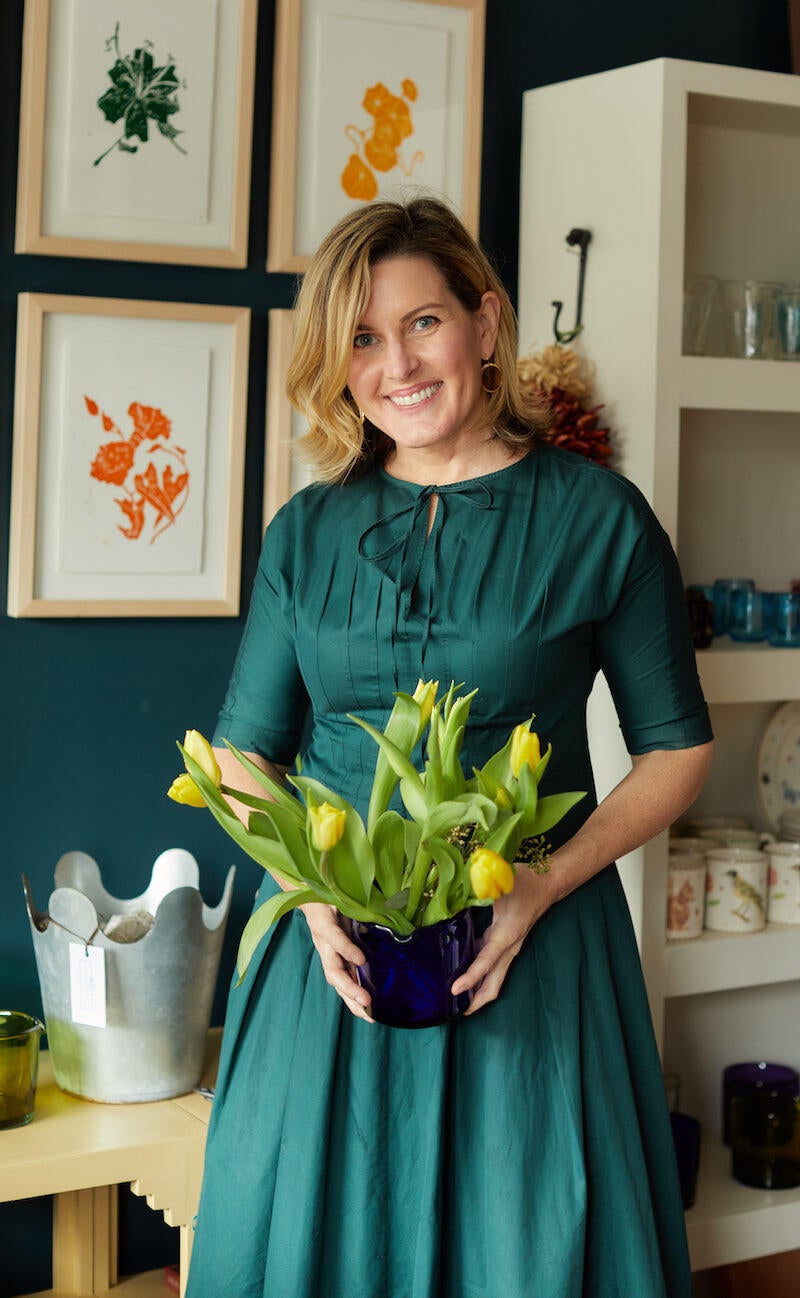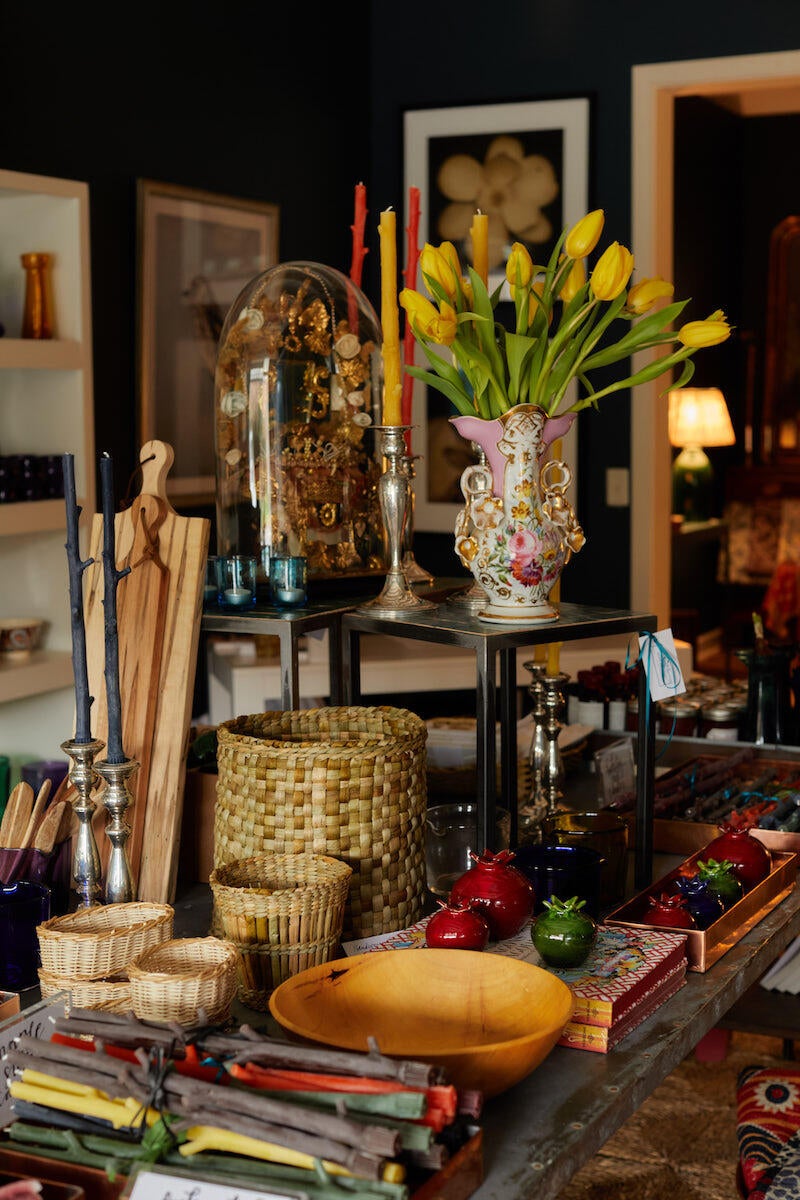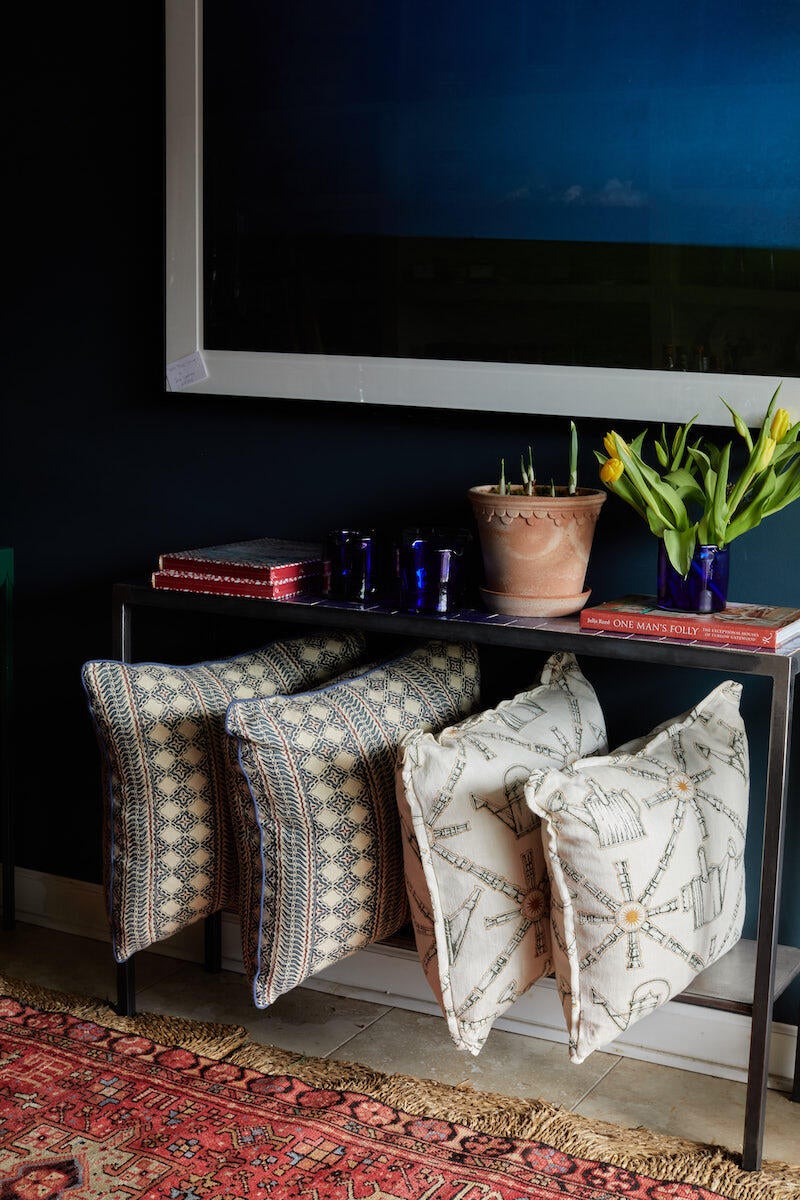In Business of Home’s series Shop Talk, we chat with owners of home furnishings stores across the country to hear about their hard-won lessons and challenges, big and small. This week, we spoke with Nashville-based Keith Smythe Meacham, the co-founder of Reed Smythe & Company.

Reed Smythe began as an online-only enterprise offering Southern-inspired pieces for the home, launched by two best friends less than a year before the pandemic began. Smythe Meacham’s business partner was Julia Reed, the widely read and beloved design writer and former food columnist for The New York Times Magazine, among other outlets. Following Reed’s death in 2020, Smythe Meacham wondered if she could or should continue their company—but ultimately decided to press on, expanding to a brick-and-mortar location in Nashville in late 2021. Here, she discusses that painful decision, the nitty-gritty of her e-comm successes, and what’s going on with the brand’s wacky logo.
What was your career like before the shop?
This is an about-face for me, in a way. I started Reed Smythe with my very dear friend, Julia Reed, about three years ago, before she passed away of cancer. Before that, I was in the education field for about 25 years. My last job was co-founding an education technology company called Homer. We essentially taught kids to read on the iPad. The connective tissue is that I was the vice president of marketing and branding there, and I learned so much about selling things online, digital marketing, how to speak to an audience.
When Julia came to me and said, “I’ve always wanted to start a marketplace where people can find beautiful things for their house that they can’t find anywhere else, made by artists and artisans,” I said, “No, no, no. I’m in this other field, and I’m not the right person for you.” And she said, “You’re the perfect person.” A lot of my life and especially my friendship with Julia had been spent entertaining and decorating houses and loving the design world: following shelter magazines and designers, obsessing over rooms in my own house and the houses of my friends. It was more logical than I think it looks on paper.
It started entirely online, right? What was the initial suite of products?
Julia had started a company called Catfish & Henry, named after her beloved beagle; she developed a handful of products, and I had helped her with that. [We’d] get a coppersmith to make something for [her], or a welder to build a great coffee table. So when Julia got interested in doing something more, I said, “Let’s do this online because that’s going to have the greatest reach.” We built the MVP [minimum viable product] of a website, which was pretty but not as high-functioning as our site now, and launched in May 2019. We did a lot of pop-ups around the country, so even though it was very much an online operation, we also had a physical presence.
We’ve always had a commitment to offering products hand-made by American or European artisans. We certainly welcome artisans from other countries, but there’s a lot of research and collaboration that goes into the work we do. About 90 percent of our products are either co-created with artisans or made by artisans of their own design.
When did you decide you were in a good-enough spot to progress to brick-and-mortar?
I think Julia always wanted some physical presence, but we were really thinking of it more as marketing—a space with our things laid out almost like a house. We were really focused on getting the website up and running, and getting the numbers working really well.
When she passed away [in August 2020], I honestly didn’t know if I would continue the venture, because it was so connected to the two of us, and obviously there was a period of mourning. I decided it would be a tribute to her to continue it. So in November 2021, I opened this teeny-tiny jewel box in Nashville, and I did it in the same way that we had always talked about—set it up like a house where people can sit down and talk and visit. We have book signings and cocktail parties.
It’s been very surprising to me how resonant brick-and-mortar has been. People are really appreciative of having a place to go to see what we are selling, to feel it and touch it. Doing the budget the first year, I imagined the store would contribute in a de minimis way to the whole business, but it has exceeded my expectations and my dreams.
What is the vibe of the store?
It has a front and a back room. The walls are painted this dark blue that showcases art well. We’ve got some great antiques, the only thing we focus on besides artisan-made products. We’ve got a daybed up in the front, and people lounge on it when they come in. We’re always mounting new art as it sells. Sometimes we install a series and invite people over for wine and to look at the new pieces on the walls.

What is your process of finding these artisans?The initial process was identifying the white spaces in our houses: What are the things we’d love to have that we’re not seeing? Then [we’d] look around our own collections and find things that we’d like to reproduce: antiques, tabletop, planters. We said, “OK, we want a glassblower to reproduce Victorian pieces, a metalworker, a coppersmith, a bronze-maker, a woodworker, some great ceramics.” So the initial collection was about materials and identifying great artists.
Our glassblower is up in Vermont, and he’s been wonderful about allowing us to send antique pieces and using them as inspiration. We have a gorgeous line of colored glass goblets, wine rinsers, Victorian bulb vases, tumblers. I [also] started traveling to France and Spain, going to artisan markets and bringing back inspiration to the U.S., or working with people there to produce those things. The third [sourcing method] is the internet, hashtag searching for a craft or a form that I love. I try to work with small artists who are not being picked up by other businesses so that we have unique things.
And sometimes I’m working with artist friends. I have a great sculptor friend down in New Orleans [Ashley Pridmore], and she does really big civic installations usually, but she’s so talented at small things. I wanted a tulipiere in our collection, and she created the resin cast for this great, modern tulipiere that’s been selling like crazy. So those are the ways we source things.
I’ve read that the through line of the store is its Southern roots. What does that mean to you?
Julia and I both grew up in the Mississippi Delta, [which] has this wonderful tradition of entertaining that’s both very formal—in the sense that you’re using beautiful things and your grandmother’s silver and china—and very informal in that you’re flopping down on a couch and walking around on tattered oriental rugs. It’s this World of Interiors feel. The parties were always high-low. Growing up in that world and then going to New York, where things were much more buttoned-up, we missed the fun of the places we grew up in. That was part of the inspiration—this way of bringing eclectic, collectible things to the market.
Will you tell me about your fish-and-key logo?
We always knew that people might not understand it, but we didn’t care because we loved it. It’s a catfish, and it was inspired by this papier-mâché catfish hanging in the store. Whenever [the staff] travel or do any pop-ups, we bring our catfish. It was originally on a Mardi Gras float, but we found it in an antiques shop in Charlottesville, Virginia, and it became the company’s mascot. The catfish is a beloved fish of the Mississippi Delta and the Mississippi River. It’s a low-feeding common fish, and we were thinking again about a shop where you could find the high and the low of entertaining. Then the key is a symbol of home, opening up doors and welcoming people in. That is the inspiration behind our weird logo!
What’s an object or a category that does really well for you?
Our glassware is always our bestseller. People love colored glass. Ours is a little thicker [than what you typically see in the marketplace] and more brilliant in terms of the jewel-tone colors. We also carry a lot of Mocha ware; I collect Mocha ware myself, which is a form of pottery born in 18th century [England]. It landed in the New World in a lot of taverns. It has these earthworm patterns, and it’s much more popular now, I think as a result of these fantastic English influencers who post their beautiful houses with antiques. I found a potter in Arkansas who has brought back the art of Mocha ware production, a pretty complicated process because it takes pigmented clay and drips it in these incredible patterns—seaweed, earthworm, a cat’s eye. Those are our two bestsellers.

Has your e-comm strategy changed since you launched?
We’ve had a pretty intense shift—not in our strategy, but in our site itself. We were doing well enough that we were able to reinvest a good chunk of our profit into totally redoing the website on the back end. We initially did our back end on WordPress, and the tools there are a lot less user-friendly, so we required a ton of tech support from an outsourced team. We found a great company that makes websites, and they’re very focused on e-commerce. Looking back, our initial build was not focused enough on best practices. The new site launched June 2021, and we’ve seen our numbers go crazy; our sales funnel, from the moment someone lands on [the page] until the sale, is up by significant percentage points.
We also discovered, by looking at the data, that visuals really matter to people, so we invest in product shots that allow people to see both a beautiful image and different angles of the product. We’ve invested in a great photographer and backgrounds that are not just a white board or a lightbox. I love a light box! It’s a really clean look. But because we are this earthy Southern artisan brand, we wanted to bring some beautiful photography, and that’s been really important.
When you’re paying a good amount of money for products you’re not seeing in person, you need to be convinced by the photo.
And you really need to have at least three product photos, so people can understand it and get a close-up look at the quality. One of the other strategies we had not employed enough in the beginning was email communication. We basically shot out emails sending recipes and suggestions on decorating, and then occasionally, “Oh, here are some of our new products.” Our open rates have always been really high, and we have very loyal customers—but now, we’ve got a sequence of emails when someone visits our site. We welcome them after they first sign up, but then have a [series] of emails that introduces us, offers discounts, commemorates birthdays if they wish to give us that date. It’s a much more thoughtful way of engaging with people who love our brand.
You launched within the pandemic. Have you run into some of its issues, with inflation and the supply chain?
We do things in small batches, so we weren’t ordering huge shipments from overseas. Materials became an issue; some of our artisans couldn’t get copper or metal rods for some of the tables we make. Inflation has come a little bit later, and I think we’re seeing people be more thoughtful about what they invest in. Our average order size is pretty large per customer. I don’t want to say that our customers are inflation-proof, because I don’t think anyone is, but we definitely have customers who value beautiful things and are willing to pay for them.

What are some of the challenges of running a retail business in Nashville?
The best thing about operating in Nashville is that it’s an incredibly supportive community. And Nashville is one of the fastest-growing [metro areas] in the country—every week, I’m seeing people come in from Los Angeles and New York. There’s a booming home economy here, and we have a lot of national brands that have moved in; Schumacher has a presence here now. It’s a more vibrant place to operate a home store.
The challenge is that Nashville’s real estate is very, very expensive. As a small business, it’s hard to compete on rent. The next challenge—and we talk endlessly in Nashville about this—is that there’s not really a shopping district where you’re benefiting from your colleagues. There’s a lot of strip-mall shopping here, but it’s not villagey. I have a set of small business colleagues, and we lament the fact that there’s not one little local-business shopping district. As a shop owner, you benefit from having a critical mass of folks around you. When people come in and ask, “What are some of the other great stores in Nashville?” I can name so many! But you drive to one and then you drive to another and then you drive to another.
Lastly, I want to ask about Julia again. What is it like to operate without her?
Her voice is always in my head. Not only about the business and the products that we choose, but also about my own house and cooking. Really just—life! I mean, she was one of my closest friends in the world, and we had a nearly 30-year relationship. The loudest voice in my head from Julia is to stay true to our original vision, which is “artist-made products that are very unique.” Sometimes it’s difficult not to be offering the stuff that you could just go to market and get. One of the reasons our customers are loyal is because of that commitment. Julia would’ve said, “I don’t care if it’s easier the other way. I don’t care if it would make sales better.”
I’ve become more confident over the past year or so—knowing [when] I am choosing something that Julia wouldn’t have loved, having a debate with her in my mind about why this thing is beautiful, even if she might not have wanted it in her house. Her voice tells me to have fun and not be too uptight, because life is short and the endeavor is supposed to be joyful and creative.
Homepage image: Reed Smythe & Company expanded into a brick-and-mortar location in Nashville in late 2021 | Courtesy of Emily Dorio





























